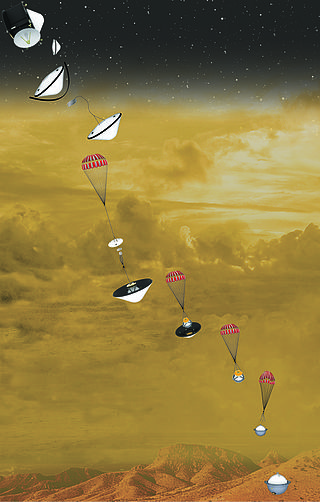Related Research Articles

Interplanetary spaceflight or interplanetary travel is the crewed or uncrewed travel between stars and planets, usually within a single planetary system. In practice, spaceflights of this type are confined to travel between the planets of the Solar System. Uncrewed space probes have flown to all the observed planets in the Solar System as well as to dwarf planets Pluto and Ceres, and several asteroids. Orbiters and landers return more information than fly-by missions. Crewed flights have landed on the Moon and have been planned, from time to time, for Mars, Venus and Mercury. While many scientists appreciate the knowledge value that uncrewed flights provide, the value of crewed missions is more controversial. Science fiction writers propose a number of benefits, including the mining of asteroids, access to solar power, and room for colonization in the event of an Earth catastrophe.

Mars Direct is a proposal for a human mission to Mars which purports to be both cost-effective and possible with current technology. It was originally detailed in a research paper by Martin Marietta engineers Robert Zubrin and David Baker in 1990, and later expanded upon in Zubrin's 1996 book The Case for Mars. It now serves as a staple of Zubrin's speaking engagements and general advocacy as head of the Mars Society, an organization devoted to the colonization of Mars.

A space settlement is a settlement in outer space, sustaining more extensively habitation facilities in space than a general space station or spacecraft. Possibly including closed ecological systems, its particular purpose is permanent habitation.

Space manufacturing or In-space manufacturing is the fabrication, assembly or integration of tangible goods beyond Earth's atmosphere, involving the transformation of raw or recycled materials into components, products, or infrastructure in space, where the manufacturing process is executed either by humans or automated systems by taking advantage of the unique characteristics of space. Synonyms of Space/In-space manufacturing are In-orbit manufacturing, Off-Earth manufacturing, Space-based manufacturing, Orbital manufacturing, In-situ manufacturing, In-space fabrication, In-space production, etc.
Spacecraft design is a process where systems engineering principles are systemically applied in order to construct complex vehicles for missions involving travel, operation or exploration in outer space. This design process produces the detailed design specifications, schematics, and plans for the spacecraft system, including comprehensive documentation outlining the spacecraft's architecture, subsystems, components, interfaces, and operational requirements, and potentially some prototype models or simulations, all of which taken together serve as the blueprint for manufacturing, assembly, integration, and testing of the spacecraft to ensure that it meets mission objectives and performance criteria.
Aerospace architecture is broadly defined to encompass architectural design of non-habitable and habitable structures and living and working environments in aerospace-related facilities, habitats, and vehicles. These environments include, but are not limited to: science platform aircraft and aircraft-deployable systems; space vehicles, space stations, habitats and lunar and planetary surface construction bases; and Earth-based control, experiment, launch, logistics, payload, simulation and test facilities. Earth analogs to space applications may include Antarctic, desert, high altitude, underground, undersea environments and closed ecological systems.

The NASA Innovative Advanced Concepts (NIAC) is a NASA program for development of far reaching, long term advanced concepts by "creating breakthroughs, radically better or entirely new aerospace concepts". The program operated under the name NASA Institute for Advanced Concepts from 1998 until 2007, and was reestablished in 2011 under the name NASA Innovative Advanced Concepts and continues to the present. The NIAC program funds work on revolutionary aeronautics and space concepts that can dramatically impact how NASA develops and conducts its missions.

Asteroids, including those in the asteroid belt, have been suggested as possible sites of space colonization. Motives include the survival of humanity, and the specific economic opportunity for asteroid mining. Obstacles include transportation distance, temperature, radiation, lack of gravity, and psychological issues.

In space exploration, in situ resource utilization (ISRU) is the practice of collection, processing, storing and use of materials found or manufactured on other astronomical objects that replace materials that would otherwise be brought from Earth.

The idea of sending humans to Mars has been the subject of aerospace engineering and scientific studies since the late 1940s as part of the broader exploration of Mars. Long-term proposals have included sending settlers and terraforming the planet. Currently, only robotic landers and rovers have been on Mars. The farthest humans have been beyond Earth is the Moon, under the U.S. National Aeronautics and Space Administration (NASA) Apollo program which ended in 1972.

Space architecture is the theory and practice of designing and building inhabited environments in outer space. This mission statement for space architecture was developed in 2002 by participants in the 1st Space Architecture Symposium, organized at the World Space Congress in Houston, by the Aerospace Architecture Subcommittee, Design Engineering Technical Committee (DETC), American Institute of Aeronautics and Astronautics (AIAA).
Interplanetary contamination refers to biological contamination of a planetary body by a space probe or spacecraft, either deliberate or unintentional.

Austere Human Missions to Mars is a concept for a human mission to Mars by the United States space agency, NASA. Released in 2009, it proposed a modified and even less costly version of Design Reference Architecture (DRA) 5.0, itself a combination of nearly 20 years of Mars planning design work. The mission profile was for a conjunction class with a long surface stay, pre-deployed cargo, aerocapture and propulsive capture, and some in-situ resource production. As of 2015, the concept had not yet been adapted to the Space Launch System that replaced NASA's Constellation program in 2011.

A Mars habitat is a hypothetical place where humans could live on Mars. Mars habitats would have to contend with surface conditions that include almost no oxygen in the air, extreme cold, low pressure, and high radiation. Alternatively, the habitat might be placed underground, which helps solve some problems but creates new difficulties.

DAVINCI is a planned mission for an orbiter and atmospheric probe to the planet Venus. Together with the separate VERITAS mission, which will also study Venus, it was selected by NASA on June 2, 2021 to be part of their Discovery Program. Its acronym is inspired by Leonardo da Vinci in honor of his scientific innovations, aerial sketches and constructions.

NASA's Lunabotics Challenge

The Europa Lander is an astrobiology mission concept by NASA to send a lander to Europa, an icy moon of Jupiter. If funded and developed as a large strategic science mission, it would be launched in 2027 to complement the studies by the Europa Clipper orbiter mission and perform analyses on site.

Martian Moons eXploration (MMX) is a robotic space probe set for launch in 2026 to bring back the first samples from Mars' largest moon Phobos. Developed by the Japan Aerospace Exploration Agency (JAXA) and announced on 9 June 2015, MMX will land and collect samples from Phobos once or twice, along with conducting Deimos flyby observations and monitoring Mars's climate.

A space habitat in a basic sense is any facility providing shelter and fulfilling habitational purposes in outer space. It is not to be confused with an extended space settlement, an arrangement of or infrastructure for multiple habitation facilities, in the sense of a space settlement. Space stations or theoretical extraterrestrial stations, such as a Moonbase or Mars habitat, include or are basic space habitats.

The Planetary Exploration of China, also known as Tianwen, is the robotic interplanetary spaceflight program conducted by the China National Space Administration (CNSA). The program aims to explore planets of the Solar System, starting from Mars, and will be expanded to Jupiter and more in the future.
References
- ↑ Kennedy 2002
- ↑ Smith 1993
- ↑ Soureshjani, Omid Karimzade; Massumi, Ali; Nouri, Gholamreza (2023). "Sustainable colonization of Mars using shape optimized structures and in situ concrete". Scientific Reports . 13: 15747. doi: 10.1038/s41598-023-42971-9 . PMC 10514203 .
Citations
- M.M. Cohen; K.J. Kennedy (1997). Habitats and Surface Construction Technology and Development Roadmap. In A. Noor, J. Malone (Eds.), Government Sponsored Programs on Structures Technology (NASA CP-97-206241, p. 75-96). Washington, DC, USA: National Aeronautics and Space Administration.
- K.J. Kennedy (2002). The Vernacular of Space Architecture (AIAA 2002-6102). 1st Space Architecture Symposium (SAS 2002), Houston, Texas, USA, 10–11 October 2002. Reston, Virginia, USA: American Institute of Aeronautics and Astronautics.
- A. Smith (1993). Mechanics of Materials in Lunar Base Design. in H. Benaroya (Ed.) Applied Mechanics of a Lunar Base, Applied Mechanics Review, Vol 46, No 6. pp. 268–271.